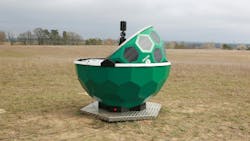AI-Driven Drones for Wildfire Detection and Suppression for Utilities
As wildfires grow in intensity and frequency, utilities face mounting challenges in protecting critical infrastructure and ensuring grid reliability. The recent Los Angeles wildfires, estimated to cost more than $250 billion in damages, underscore the urgent need for innovative fire mitigation strategies. In response, Dryad Networks has successfully demonstrated a groundbreaking autonomous drone system, Silvaguard, designed to detect, monitor, and ultimately suppress wildfires before they escalate.
A Milestone in Autonomous Fire Suppression
On March 27 in Eberswalde, Germany, Dryad Networks showcased the Silvaguard system in action. The demonstration featured a controlled fire detected within minutes by Dryad’s Silvanet ultra-early wildfire detection system, which triggered the autonomous deployment of a Silvaguard drone. The drone provided real-time aerial imagery, pinpointing the fire’s location and size—a crucial capability for utilities managing vast transmission corridors in fire-prone regions.
Dryad’s CEO, Carsten Brinkschulte, emphasized the urgency of reducing wildfire response times: “With wildfires growing more destructive each year, ultra-early detection alone may no longer be enough. Silvaguard represents a critical leap forward toward the vision of AI-powered drones extinguishing fires before they spread.”
Integrated Technology for Proactive Fire Management
The Silvanet system, already deployed in over 50 locations worldwide, uses solar-powered gas sensors to detect wildfires at their smoldering stage. It transmits real-time alerts, allowing for rapid response—critical for utilities that must act swiftly to prevent fires from damaging transmission and distribution infrastructure.
Silvaguard enhances this capability by automating response measures. In future iterations, the drone system will not only monitor fires but also deploy suppression technologies, such as acoustic wave fire suppression, to extinguish flames in their earliest stages. This end-to-end solution could provide utilities with a powerful tool to minimize fire-related outages and liabilities.
Implications for Utilities and Infrastructure Operators
Wildfires pose a significant risk to power grids, causing infrastructure damage, widespread outages, and liability exposure. Utilities in high-risk areas—such as California, Australia, and Southern Europe—are increasingly investing in wildfire mitigation strategies, and Dryad’s integrated system could become a vital asset.
Potential applications for utilities include:
-
Grid Protection: Early detection and rapid suppression of fires near power lines reduce the risk of infrastructure damage and service disruptions.
-
Liability Reduction: Autonomous suppression technology could help utilities demonstrate proactive wildfire mitigation, potentially reducing exposure to legal and financial consequences.
-
Regulatory Compliance: Governments and regulatory bodies are tightening wildfire mitigation requirements for utilities. Deploying advanced detection and suppression systems aligns with evolving standards for fire risk management.
Future Developments and Industry Collaboration
Silvaguard is currently in its first phase, focusing on detection and situational awareness. The next stage will integrate fire suppression capabilities, with rigorous testing planned for various suppression technologies. Dryad is also exploring AI-driven decision-making and multi-drone coordination to optimize large-scale deployment.
Co-funded by the European Union with €3.8 million in grants and loans, the project is inviting collaboration from policymakers, utilities, and wildfire management professionals. As utilities worldwide grapple with escalating wildfire threats, integrating AI-driven drone technology into wildfire prevention strategies could be a game-changer for grid resilience and safety.
With wildfires posing an ever-growing challenge, utilities must look to cutting-edge technologies like Silvanet and Silvaguard to protect infrastructure, reduce costs, and enhance public safety. Dryad’s latest demonstration marks a promising step toward a future where autonomous fire suppression could drastically reduce the impact of wildfires on the power grid and beyond.
